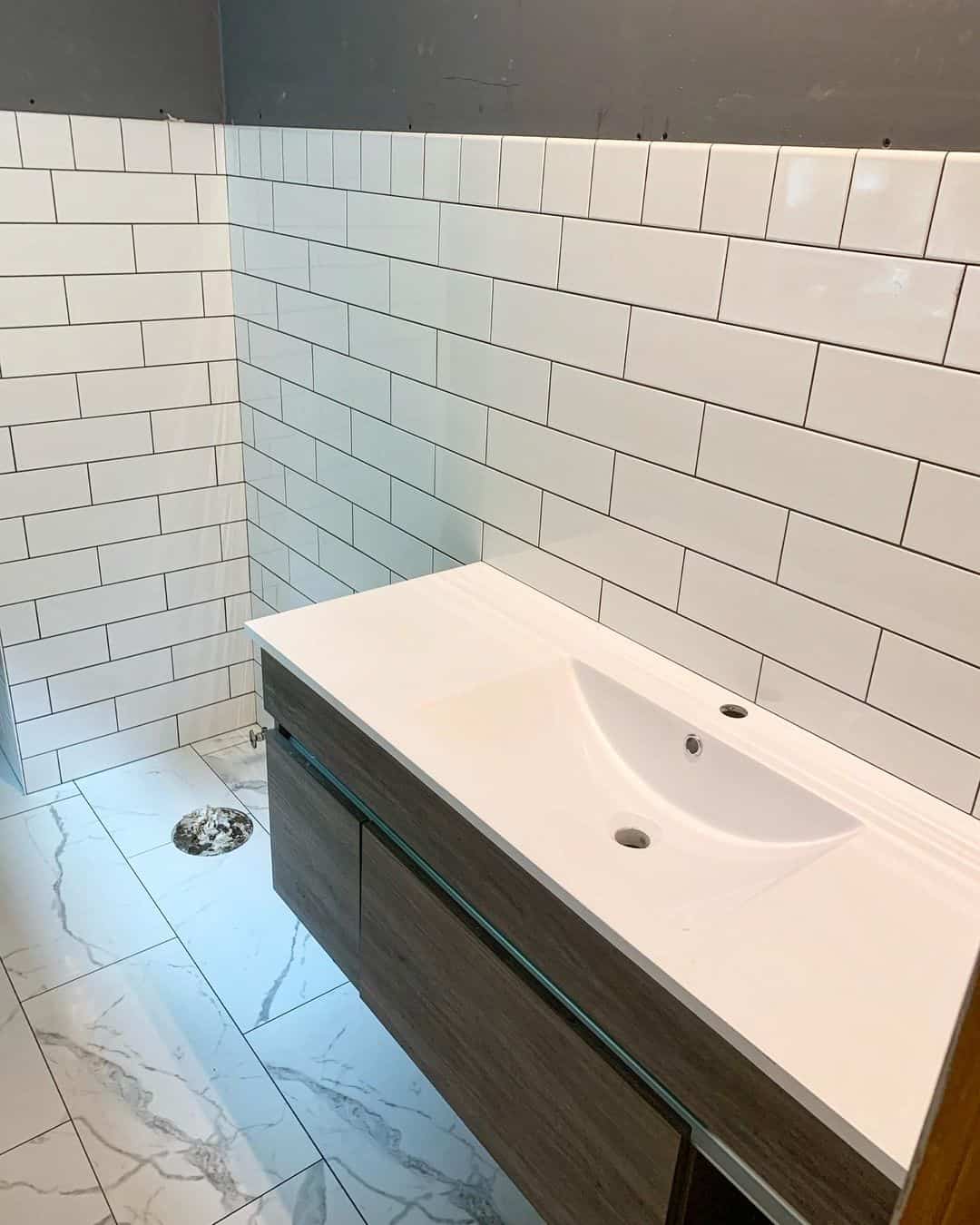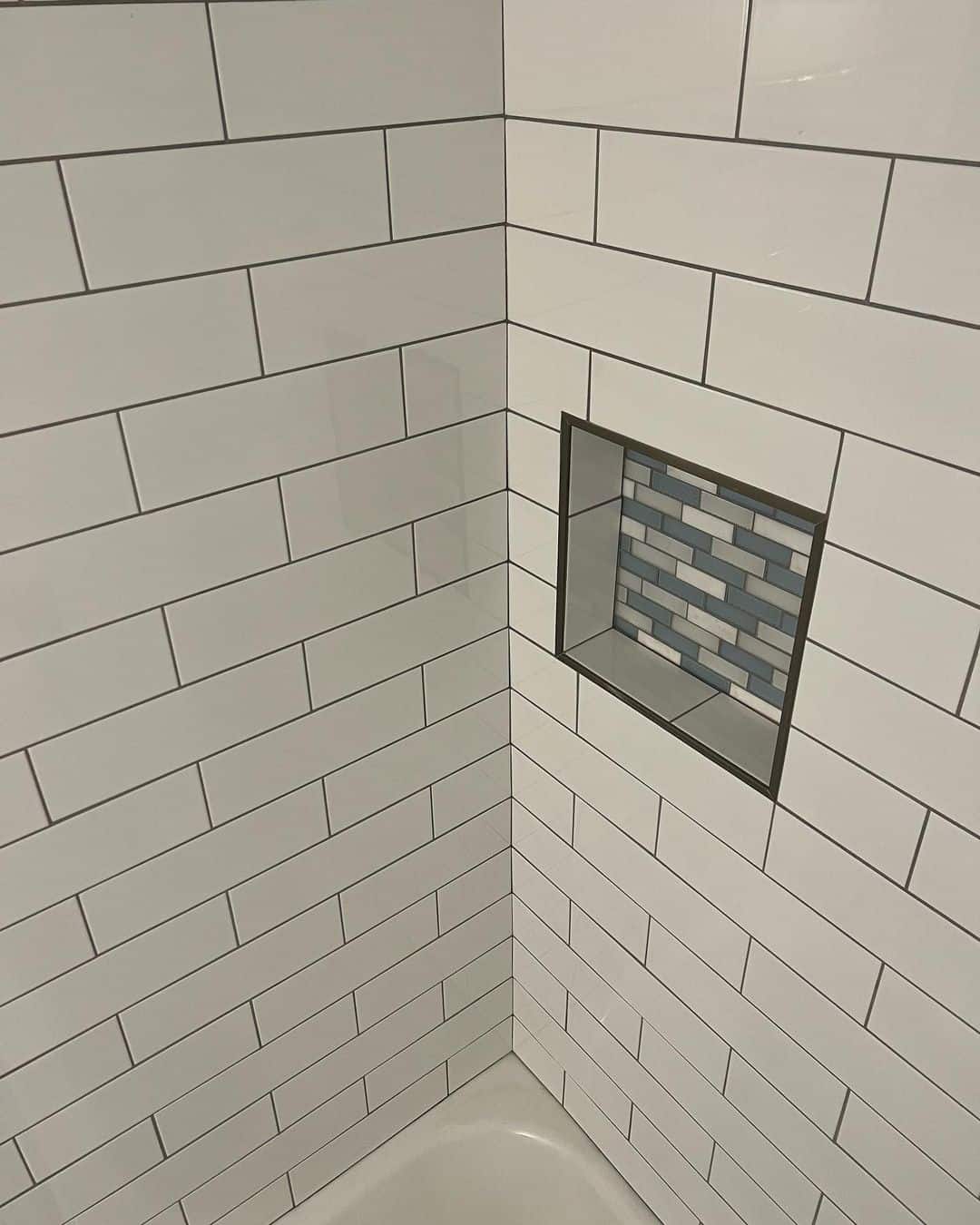Grout lines are among the most important things to consider when placing tiles in your home, preventing dirt, dust, and water from gathering between tiles.
Not only that, but grout offers flexibility for tiles to adjust during times of high humidity and rising temperatures. But besides their function, grouts can add a high-quality finish to your shower wall, kitchen, or utility room.
You must choose between two primary sizes when grouting a subway tile; 1/8 and 1/16. Deciding which will serve you best can be difficult, but we’re here to help.
This article will explore the advantages and disadvantages of using 1/8 and 1/16 grout line subway tiles. We’ll also share expert tips on installing and maintaining your grout, so it lasts the test of time.
Table of Contents
Firstly, what exactly is grouting, anyway?
Grout is, simply put, a mixture of cement and other ingredients, like sand and water, to produce a thick, dense material. It is commonly used to fill gaps, cracks, and spaces between tiles and fixtures like toilets and baths or to seal areas.
But grout also plays an important role in protecting your tiles too. It helps to keep tiles firmly in place, preventing them from slipping out, knocking into each other, or cracking under pressure.
Additionally, grout can prevent dirt, grime, and fungus from gathering and growing between tiles. Finally, grout can come in various colors and textures and become attractive if laid correctly between tiles.
While grout comes in various thicknesses that suit many different tiles sizes, the two most common widths for subway tiles are 1/8 and 1/16, respectively.
1/8 Vs 1/16 grout lines
Now that we’ve worked out the critical differences between 1/8 and 1/16 grout lines, it’s time to find out which will serve you best in grouting your subway tiles.
Below we’ve compared and contrasted both types across various categories, offering our recommendations and clear-cut winner in each case.
1. Ease of tile installation: Winner – 1/8 grout line
If you’re laying grout lines yourself, you might consider which type is easier to install. While both can be placed with little experience, there is a clear winner regarding easiness and overall appearance.
Because 1/8 grouting is thicker, it is generally easier to work with. Mistakes won’t be as noticeable, and you can hide slight imperfections because grout joints will look more even throughout. Additionally, thicker grout produces thicker, cleaner-looking lines, making aligning tiles much more straightforward.
On the other hand, 1/16 is a much thinner measurement, requiring more precision when placed. Slight irregularities in thickness or direction will be much more apparent and could potentially downgrade the overall appearance of your work.
2. Design potential: Winner – 1/16 grout line
While this category will vary between people and taste levels, thinner grout lines can create a better-looking, higher-quality finish.
This is because 1/16 grout lines allow tiles to be tightly packed together, allowing you to experiment with size, shape, and color patterns. Especially if you’re using intricate subway tiles, e.g., those made out of glass or mosaic, they can look attractive and polished.
That’s not to say 1/8 grout is ugly – but the thickness can make specific patterns and designs look too separated and chunky.

finertileandmasonry
3. Protecting tiles: Winner – 1/8 grout line
Ultimately, you’ll want to match your grout lines with the type and size of tile you are placing. It’s often the industry standard for floor tiles to have a minimum of 1/8 inch.
This is because a slate or ceramic tile is often rectified, i.e., it has sharp, perfect edges. A thicker 1/8 will ensure that subway tiles look uniform, smooth, and straight when laid together.
Rectified floor tiles are prone to chipping, and the thicker border will ensure they stay protected and won’t come in contact with each other. If you use a 1/16 grout, floor tiles might shift in place and come in contact with each other. This, in turn, might break them.
4. Material of grout: Winner – 1/8 grout line
Grout comes in two different materials – sanded and unsanded. These have different uses around the home and require different thicknesses that can determine which grout you ultimately pick. Firstly, let’s briefly explain what sanded and unsanded are to better explain our reasoning.
- Sanded grout contains fine sand particles, which help reduce grout shrinkage. It comes in various colors and is the default choice for kitchens, bathrooms, and shower pans. It requires a thickness of at least 1/8.
- Unsanded grout does not contain fine particles, has a reduced color palette, and can be more flimsy and unstable. Although recommended for thinner tiles like 1/16, you can still get unsanded grout in 1/8 form.
Because 1/8 comes in sanded and unsanded forms, it is the clear winner, offering a better selection of uses, material types, and color options.

yuma_tile_design
5. Cost: Winner – 1/8 grout line
Cost can be one of the deciding factors on the quality of the tiles you buy and the grout. Especially if you’re grouting an enormous surface area, you might be curious to know how much an average price is.
Because 1/16 grout lines only come in unsanded variations, we can determine that you can expect to pay the average cost per pound between $1.99 and $6.99.
1/8 grout can come in unsanded and sanded forms, the latter of which works out much cheaper per pound, averaging between $0.55 and $4.00. More affordable grout can make all the difference in buying more expensive tiles or investing in useful grouting accessories, such as a grout floater or plastic spacers.
6. Maintenance: Winner – 1/8 grout line
Like the tiles they surround, grouting can become dirty and discolored, requiring regular maintenance to look and perform at its best. Grouting can often harbor fungus and grime, which, if left unchecked, and several reduce the appeal of your room.
So which width of grouting is easier to clean?
Because of their increased thickness, 1/8-inch grout lines are much easier to treat, repair, replace and restore. This makes them ideal in rooms where moisture and dust can quickly build up, such as bathrooms, kitchens, utility rooms, and garages.
While you can still treat 1/16 grout lines, their narrow structure makes cleaning them more challenging. As such, you should place them in dry areas of your home, thus reducing the frequency of cleaning.

tilesgonewild
Expert Tips
- Generally speaking, you should expect to regrout every eight to sixteen years.
- You don’t have to grout every tile at once – sometimes, working on a smaller area at a given time can help you achieve an even application in your tiling projects. Plastic spacers can be inserted until you’re ready to grout.
- Because grouting can react to rising temperature and humidity, you should only lay it on a cool, dry day.
- Use a tool known as a grout float to force the grout into joints, ensuring a tight, clean application.
- Remember when laying grout to leave room for caulking. You can use a putty knife to create the space required.
- A thick grout line can act as a guide to aligning subsequent tiles properly.
- Sanded grout (which only comes in 1/8) offers various colors and patterns. It is a good choice if you want your grouting to match the color of the tile.
- Getting a professional to clean your grouting can be pretty expensive, with 100 square feet of grouting costing between $200-400.
- Thinner, 1/16 grout can be effective when using patterned smaller-sized tiles.
- Use a mixture of hydrogen peroxide, baking soda, and an old toothbrush to clean the grout between subway tiles.
- Grout can come in several other measurements, including 3/16, 1/4, and 3/16.
Conclusion
Ultimately, the type of grout you use for your subway tiles relies on several factors, including the room, the position of the tiles, how often you’re prepared to clean them, and the tile’s design and shape.
More often than not, 1/8 is the best choice because its thickness helps improve the overall appearance of your tiling. A 1/8 grout line also makes replacing and protecting future tiles easier, preventing them from knocking into each other and cracking.
That’s not to say 1/16 is entirely unusable. Specific tile designs might benefit from thinner grouting, but you will need more skill and patience to set it down correctly and ensure you achieve an even application.
If you have any questions about the type of grouting you should use for your subway tiles, please comment below.
But if in doubt, remember:
- Inspect grout regularly to ensure it remains free from dirt and grime. You should regrout every eight to sixteen years.
- 1/8 grout comes in both sanded and unsanded forms. 1/16 only comes in unsanded.
- In most cases, 1/8 grouting will be the ideal choice. That said, 1/16 can be effective for smaller, more intricate tiling designs.